What Is an H1 Tag?
An H1 tag is the HTML used to create the principle title on a webpage and helps point out the web page’s main subject to guests and engines like google. It comprises a gap <h1> tag, the title textual content, and a closing </h1> tag.
Right here’s an instance of an H1 tag in HTML and on the dwell web page:
H1 Tag Examples
To provide you a greater concept of what an HTML H1 tag appears like in follow, let’s see examples from totally different web sites.
The H1 tag on this Semrush Academy course is “Search engine marketing Ideas: An Important Information for Newcomers.” It’s concise, descriptive, and compelling.

The H1 tag on W3Schools’ tutorial about HTML headings is “HTML Headings.” It’s easy, correct, and matches the title of the web page.
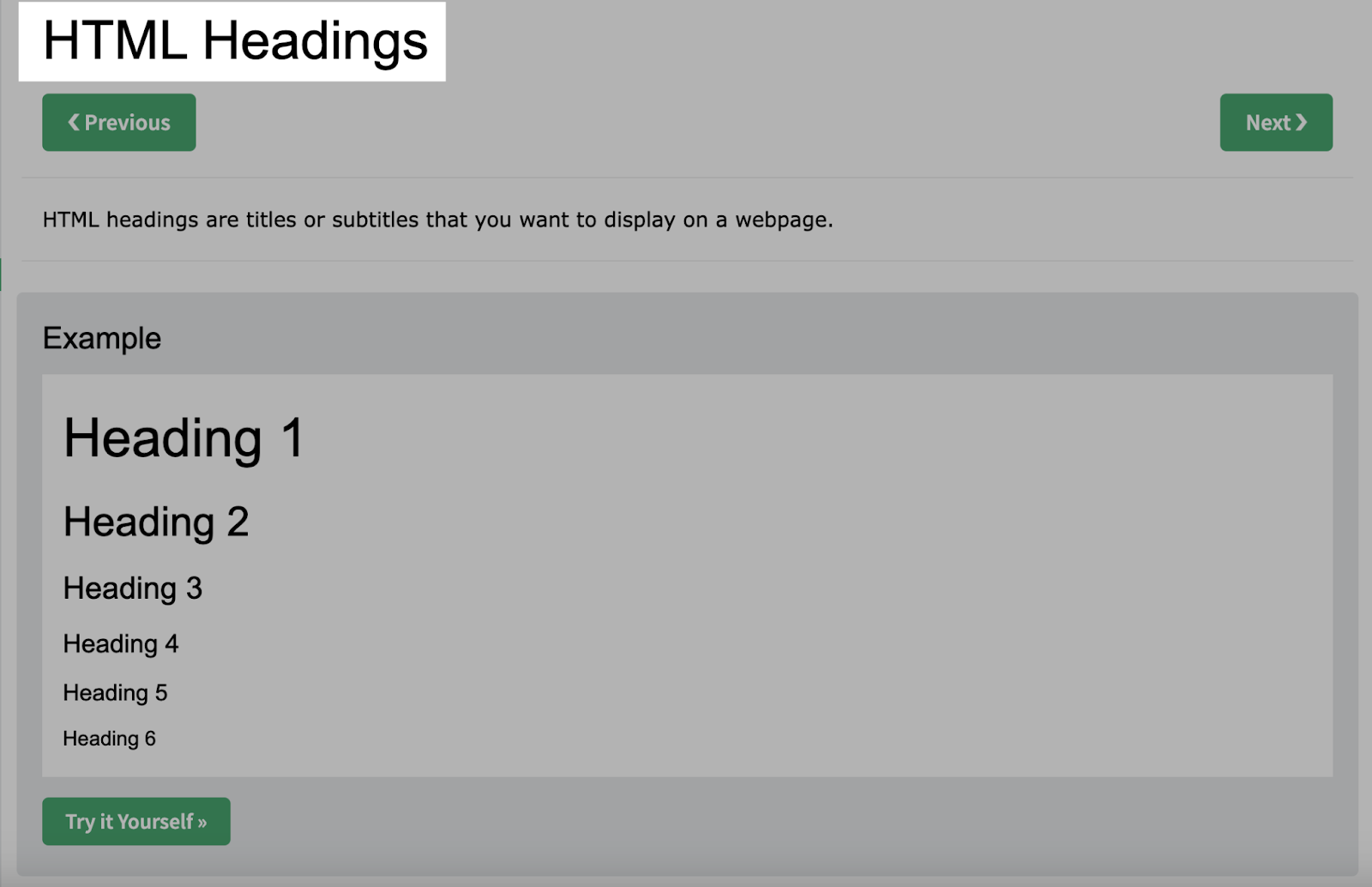
The H1 tag on this TechCrunch article is “We examined Google’s Gemini chatbot—right here’s the way it carried out.” It’s intriguing and tells the reader precisely what they’ll discover.

Easy methods to Examine H1 Tags on a Webpage
It’s straightforward to look into the H1 tags by yourself (or every other) webpages while not having particular expertise.
Listed here are among the most typical methods:
View the Web page’s Supply Code
Proper-click anyplace on a web page and choose “View Web page Supply” or “Present Web page Supply” from the menu.
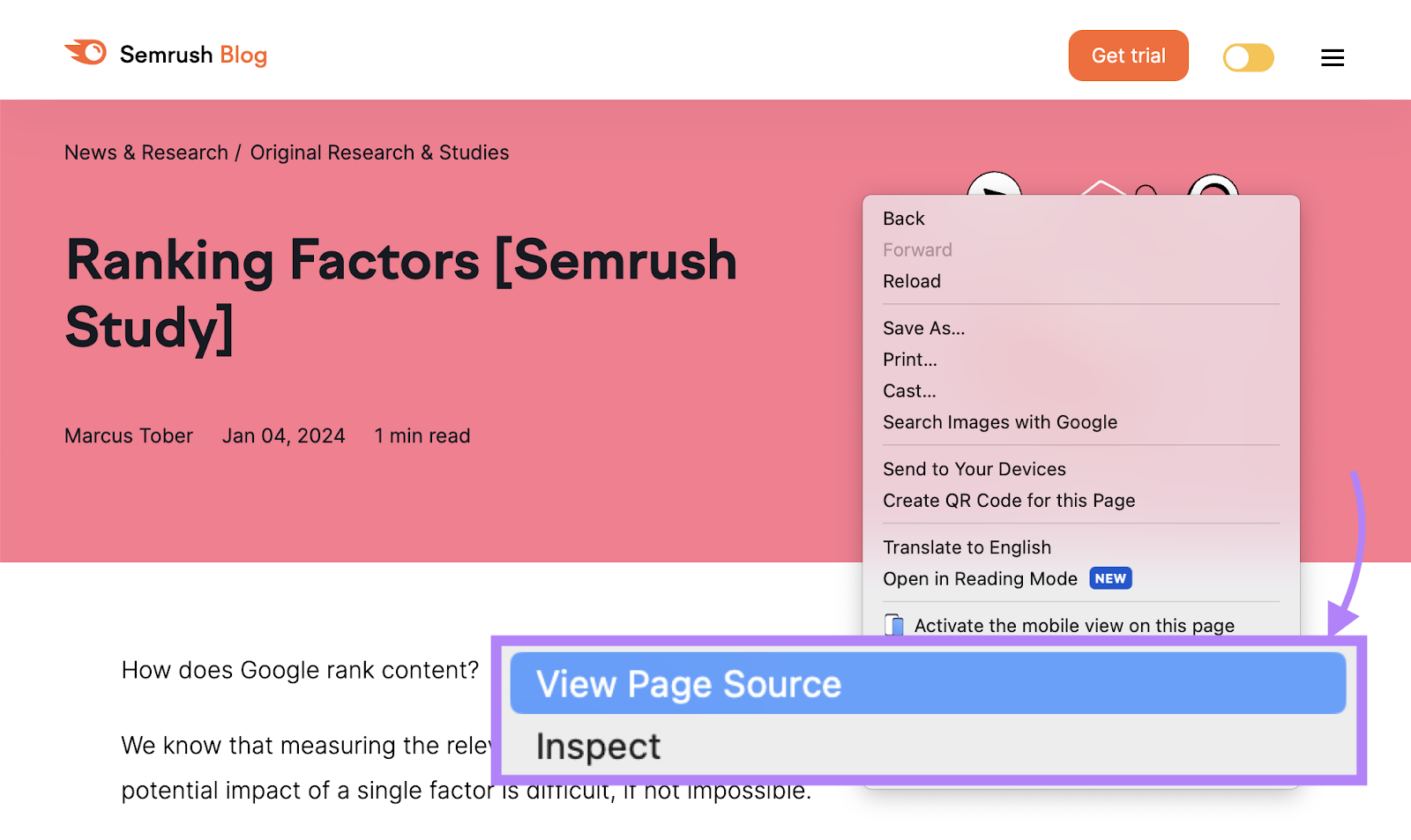
This can open a brand new tab with the web page’s supply code.
Now, you possibly can manually search for the <h1> tag.
Or use the “Command + F” shortcut on Mac or “Ctrl + F” on PC and kind “h1.”

Use a Browser Extension
You may set up a browser extension that may spotlight the H1 tags on any webpage you go to.
For instance, you should use the H-tag Chrome extension. Which can spotlight all of the <h> tags on a web page.
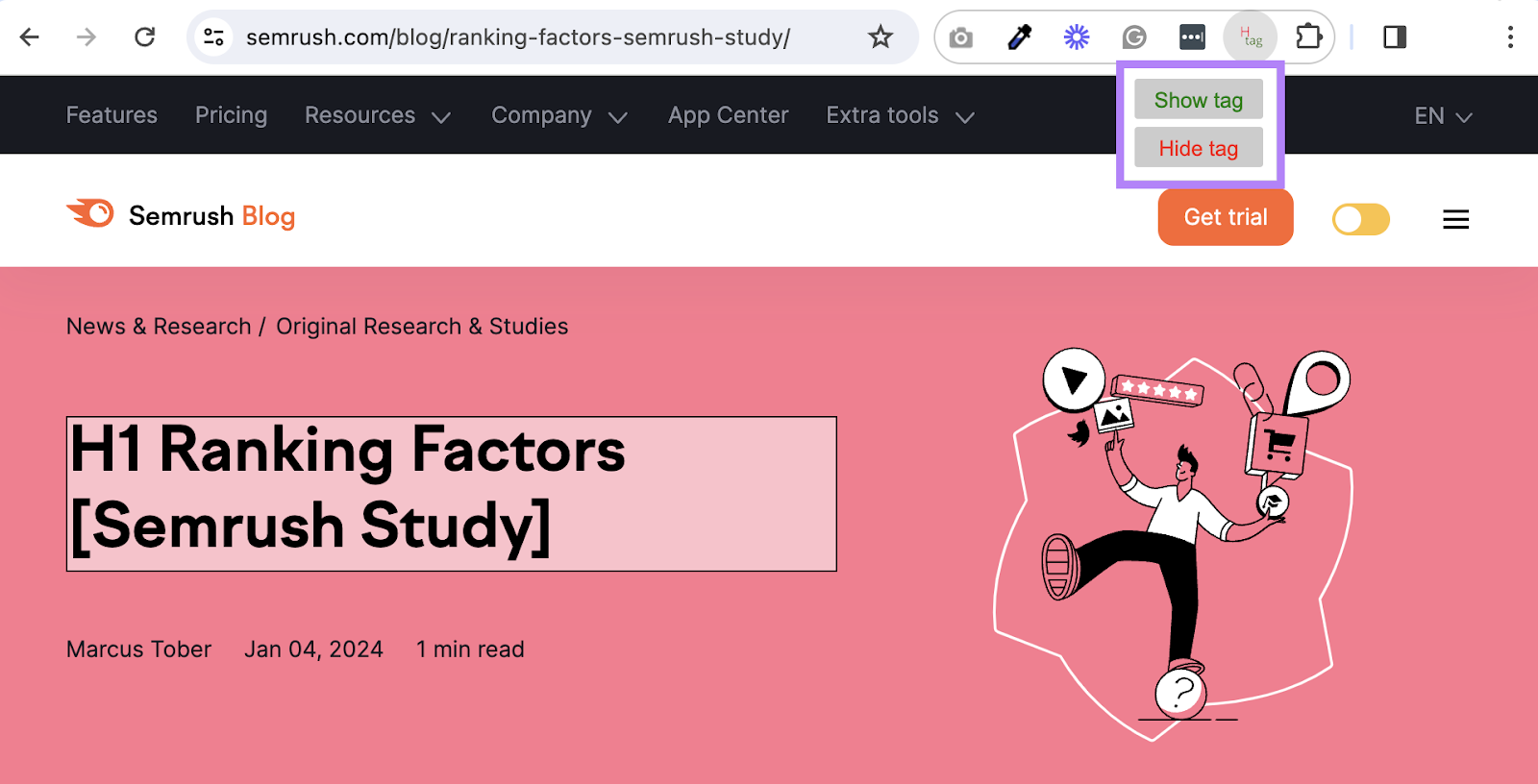
Different, extra complicated extensions like Detailed SEO Extension present tons of Search engine marketing-related insights corresponding to:
- Title tags (HTML that specifies webpage titles)
- Meta descriptions (HTML that gives web page descriptions)
- Meta robots tags (HTML that tells engines like google learn how to crawl, index, and show a web page’s content material)
- <h> tags
And extra.
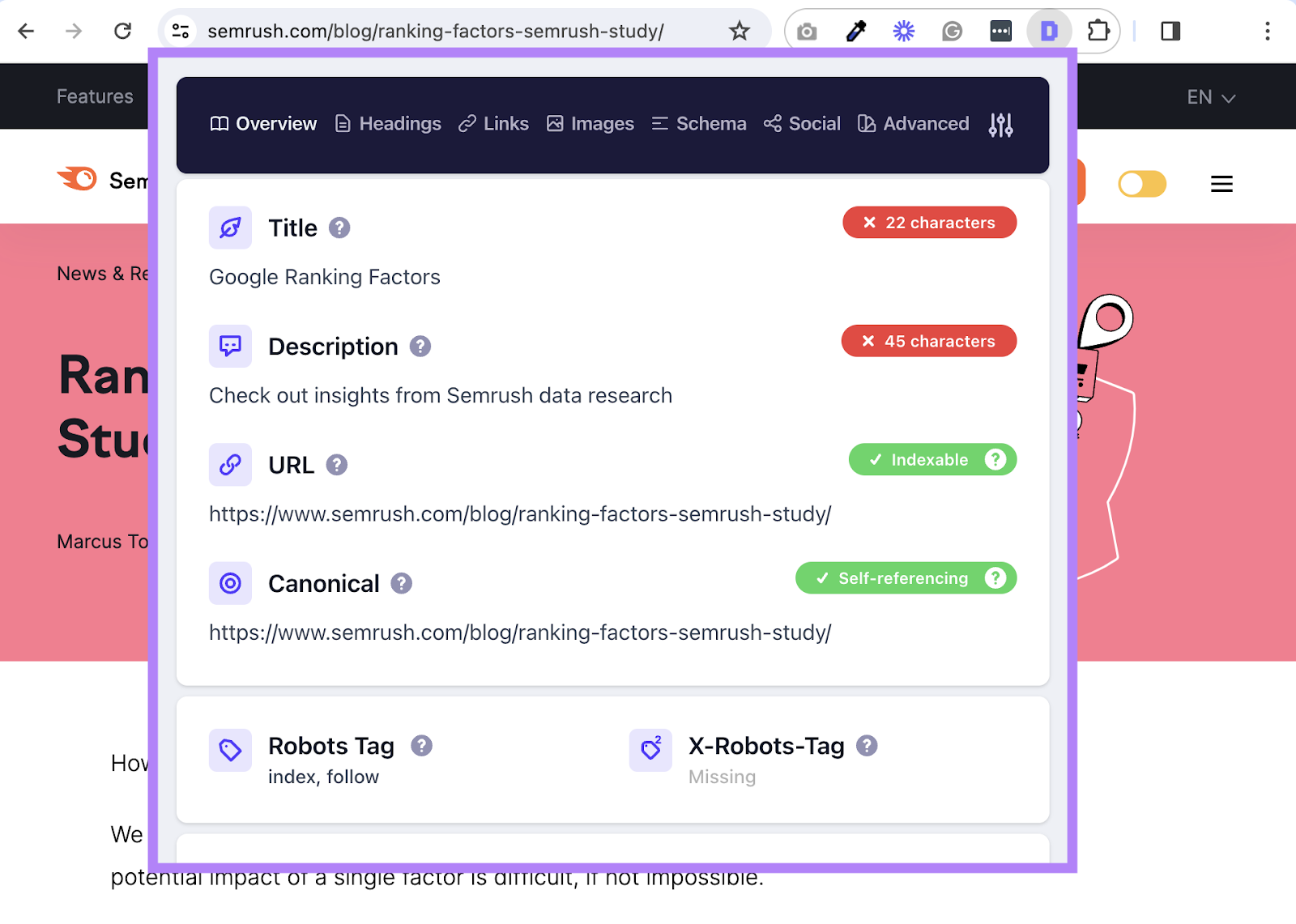
Use a Web site Audit Instrument
You need to use an internet site audit device that scans your web site to establish any points together with your H1 tags. Resembling lacking, duplicate, or empty tags.
For instance, Site Audit provides you details about your H1 tags as a part of a complete report in your web site’s well being and efficiency.
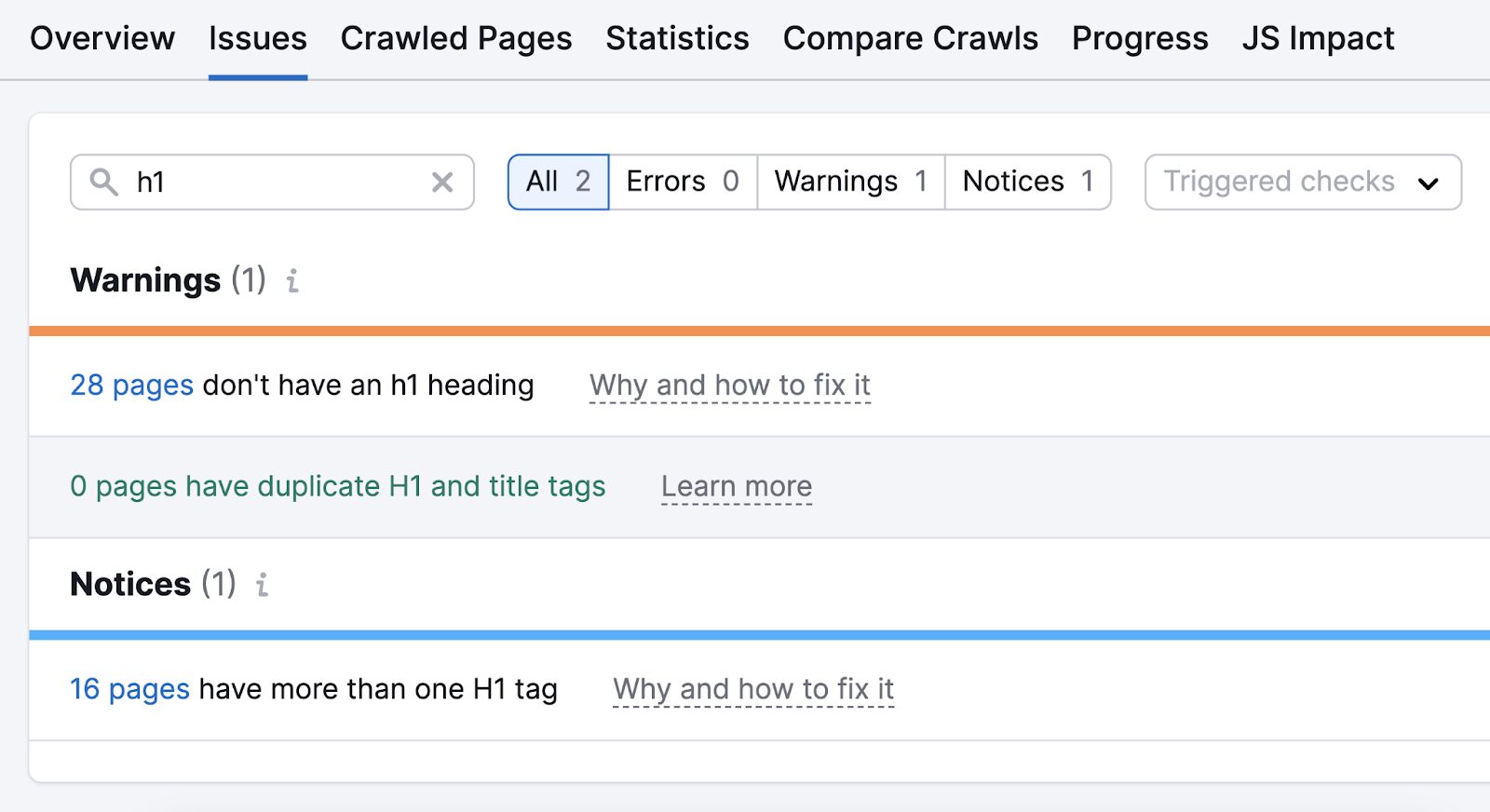
H1 tags aren’t a confirmed rating issue. However they’re nonetheless necessary for Search engine marketing.
Listed here are the highest three the reason why:
1. H1s Assist Search Engines Perceive Content material
Engines like google take a look at your H1s to find out about your pages and their content material.
The extra descriptive your H1, the higher.
The H1 on this weblog publish from Chewy is a superb instance of a descriptive H1.
It tells engines like google precisely what they’ll discover: The most effective espresso outlets with cats in the US. To make sure they’ve a better time understanding what’s on the web page.

2. H1s Enhance the Consumer Expertise
H1 tags enhance the person expertise (UX) by permitting readers to be taught what your web page is about at a look. Particularly when you think about most web sites show the H1 as the biggest textual content on the web page.
And enhancing UX is prime. Google has emphasised it contributes to better rankings.
To not point out:
A fast browse of headings can present readers what they’ll be taught earlier than they dig in. That approach, they will pre-assess your content material’s worth.
If you happen to’ve completed an excellent job, your H1 will present hierarchy and reassure guests that you’ve got the knowledge they’re searching for.
Take into account this picture:
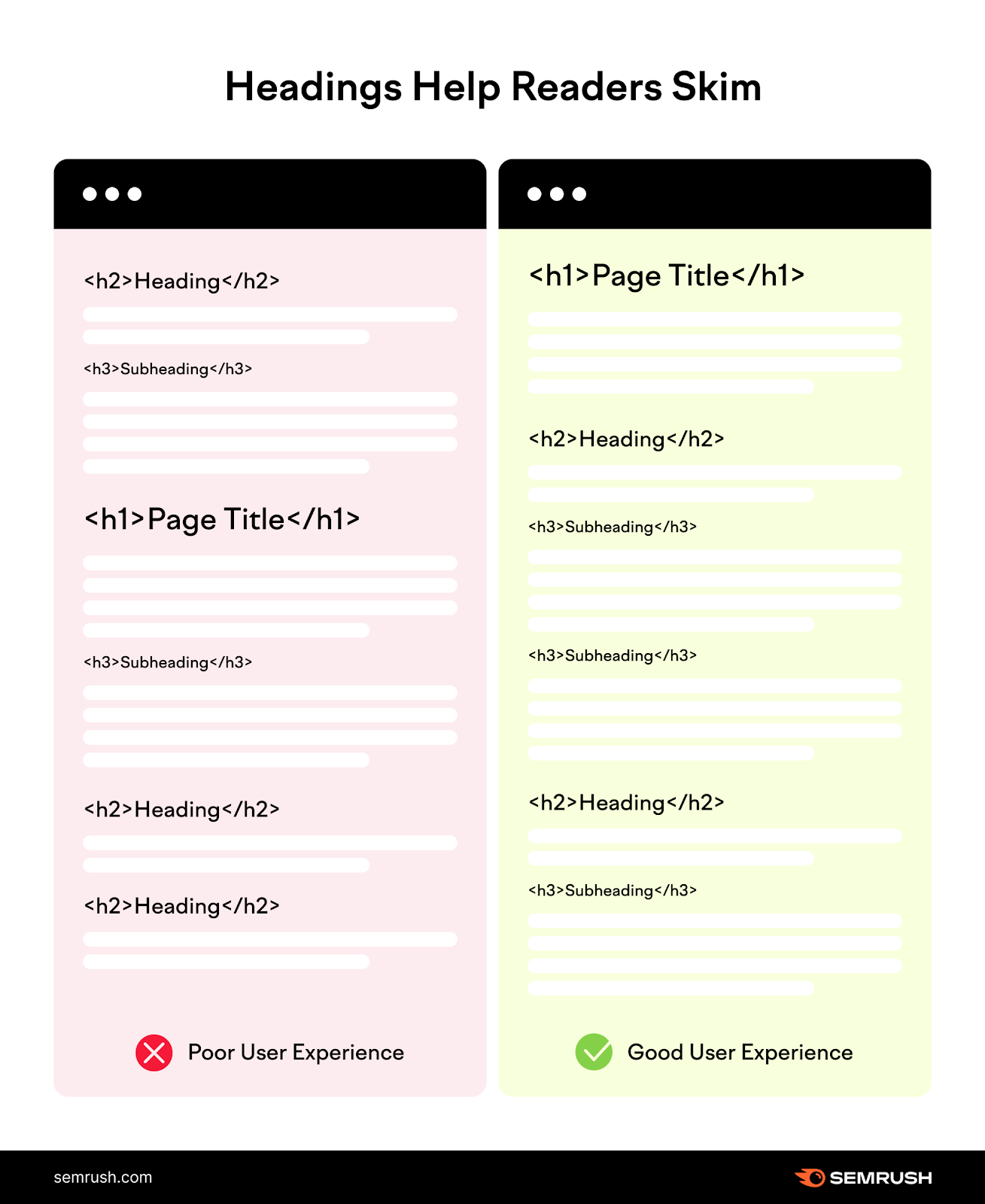
The instance on the left has no clear construction and order. It’s actually arduous to inform what the content material’s about.
The instance on the proper exhibits the H1 as probably the most outstanding heading on the web page, then H2, then H3, and many others.
It’s straightforward to skim, observe, and perceive.
3. H1s Enhance Accessibility
H1 tags (and different headings normally) may also help those that use display screen readers perceive the web page’s content material.
Display readers are packages thatcommunicate laptop textual content with a speech synthesizer or Braille show.
Right here’s an instance of how the headings in The Penn State College’s accessibility pointers seem on a display screen reader:
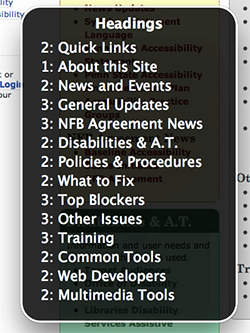
Picture Supply: The Penn State University
Shortly enhance your website’s accessibility by crafting descriptive H1 tags and preserving an organized heading construction.
Easy methods to Add H1 Tags to Your Weblog Pages
Including an H1 tag to articles in most web site content material administration methods (CMSs) is straightforward. Actually, many CMSs have a placeholder in your article title that’s robotically formatted to be your H1.
That stated, right here’s learn how to change your H1 tag utilizing WordPress, Squarespace, and Wix.
Including an H1 Tag in WordPress
Most WordPress themes are coded so the publish title is the H1.
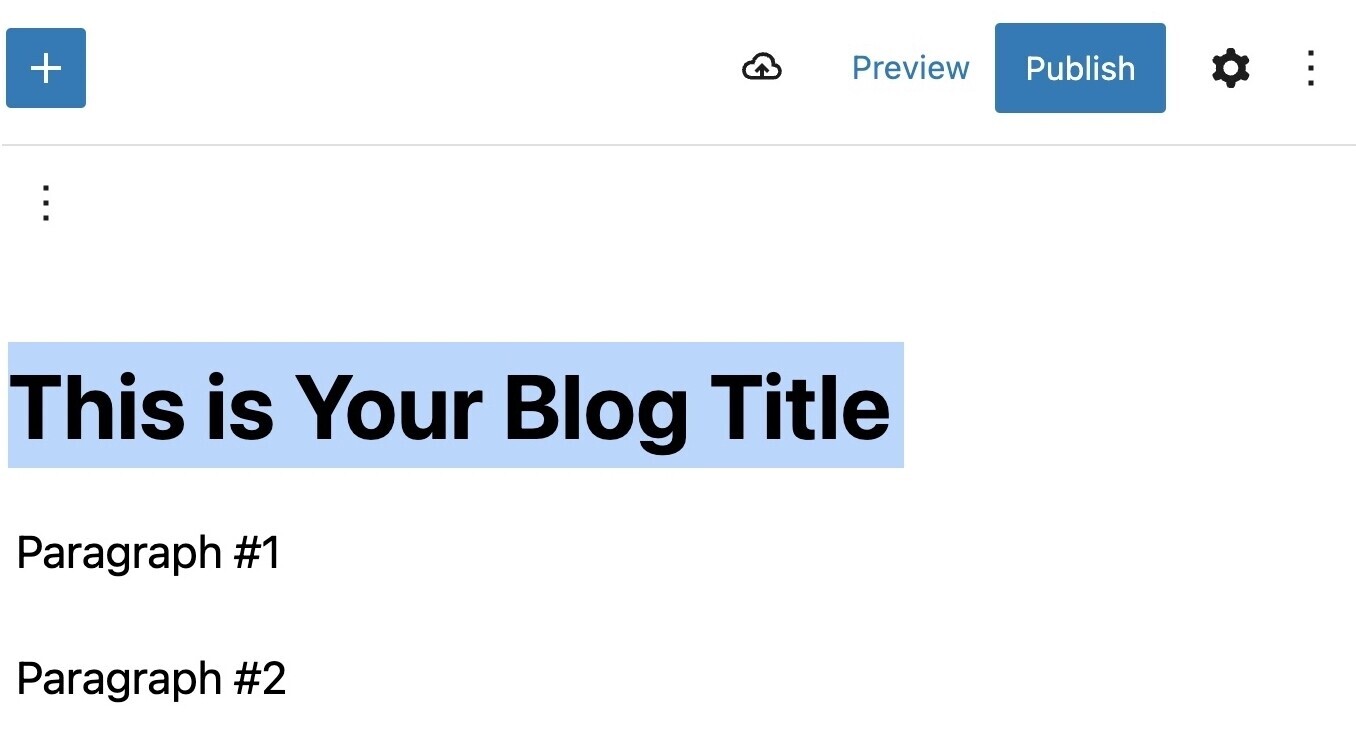
To alter this (or every other) heading, click on on or spotlight the textual content you wish to reformat. A toolbar ought to seem above your chosen block.
Like this:
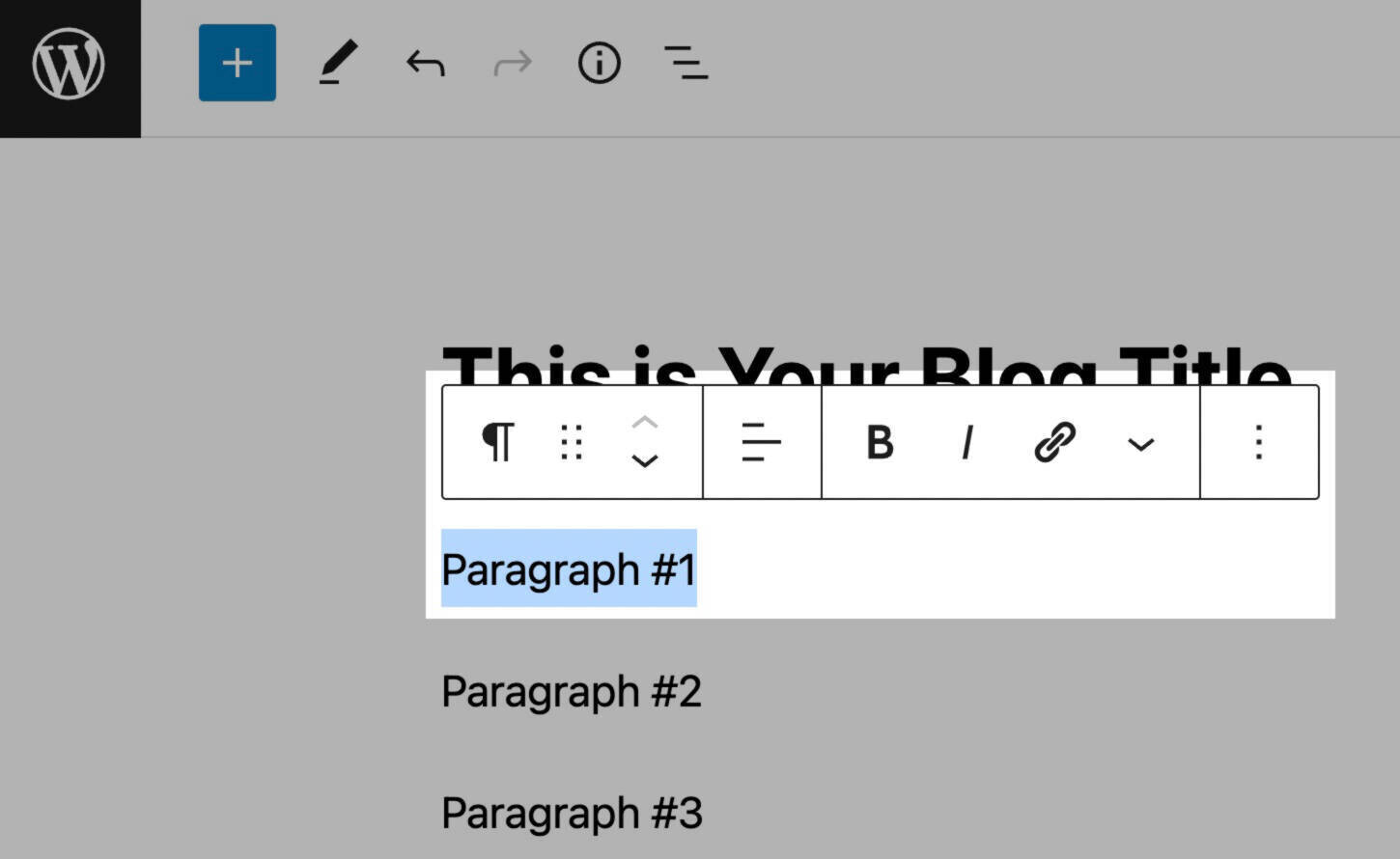
Click on on the paragraph image discovered on the left-hand aspect of that toolbar.
Then, choose “Heading.”
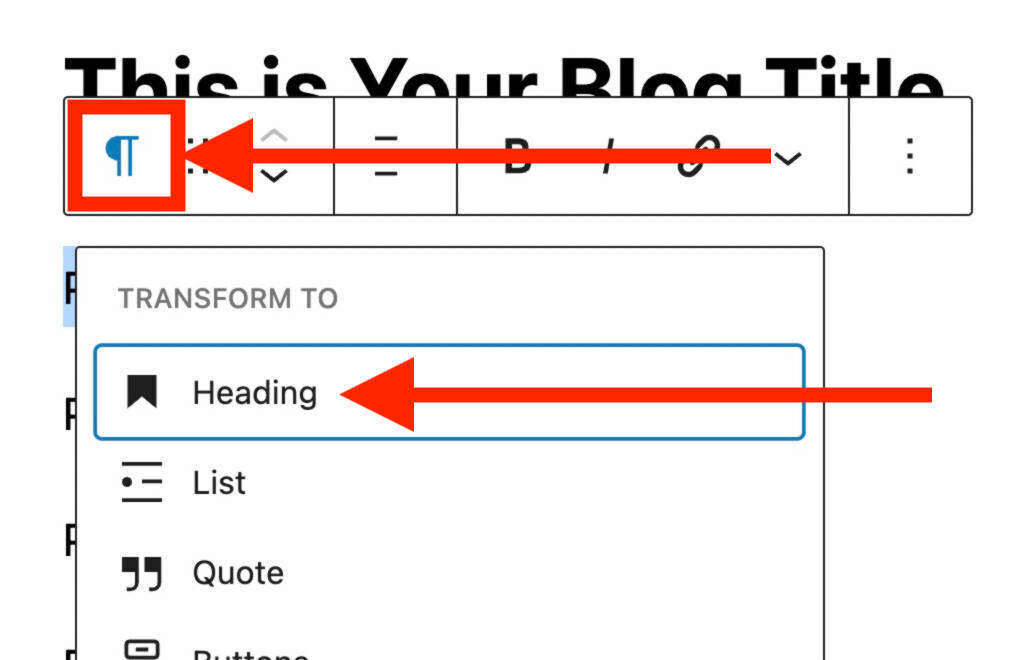
Change your heading tag to H1 by choosing “H1.”
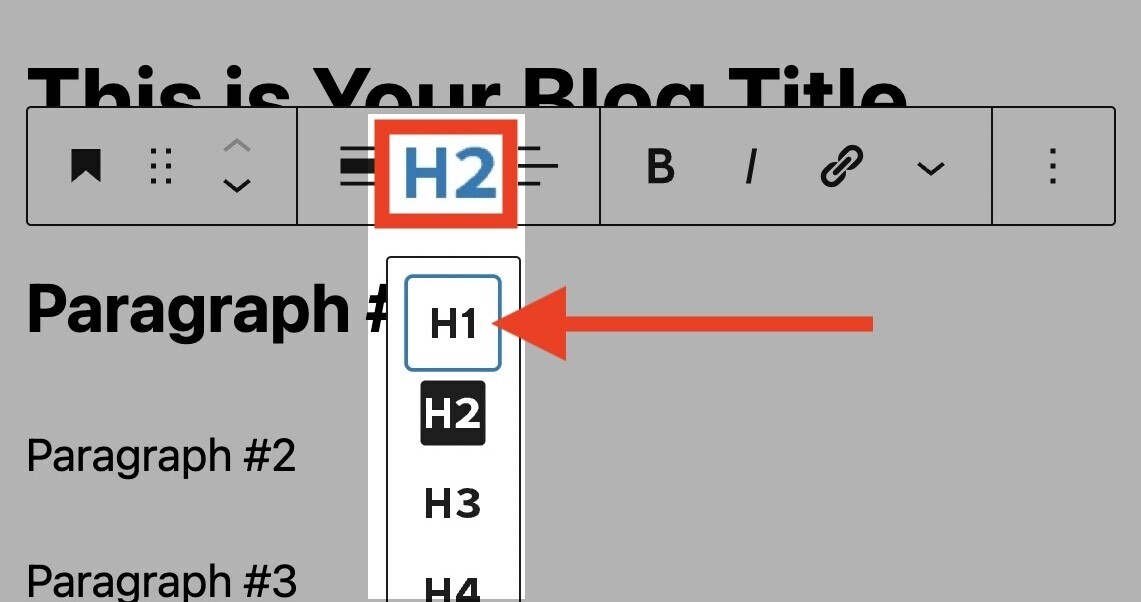
You’re all set.
Including an H1 Tag in Squarespace
Including an H1 to weblog posts in Squarespace is so simple as filling out the “publish title” subject normally.
If you wish to change the H1 tag for a web page, begin by choosing the textual content you wish to turn into an H1.
Then, click on on the formatting button on the left-hand aspect of your toolbar.
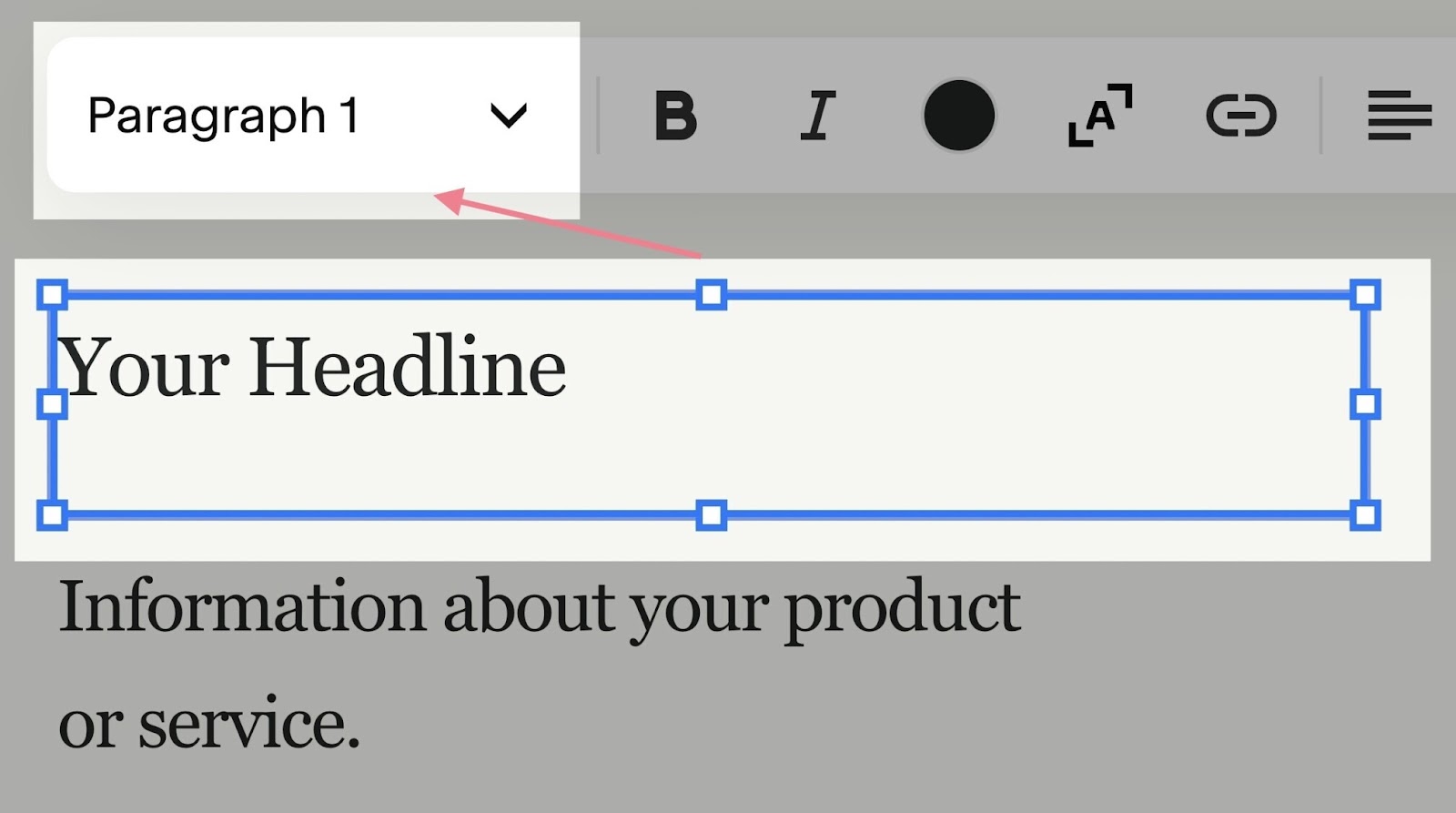
And choose “Heading 1.”
Like this:
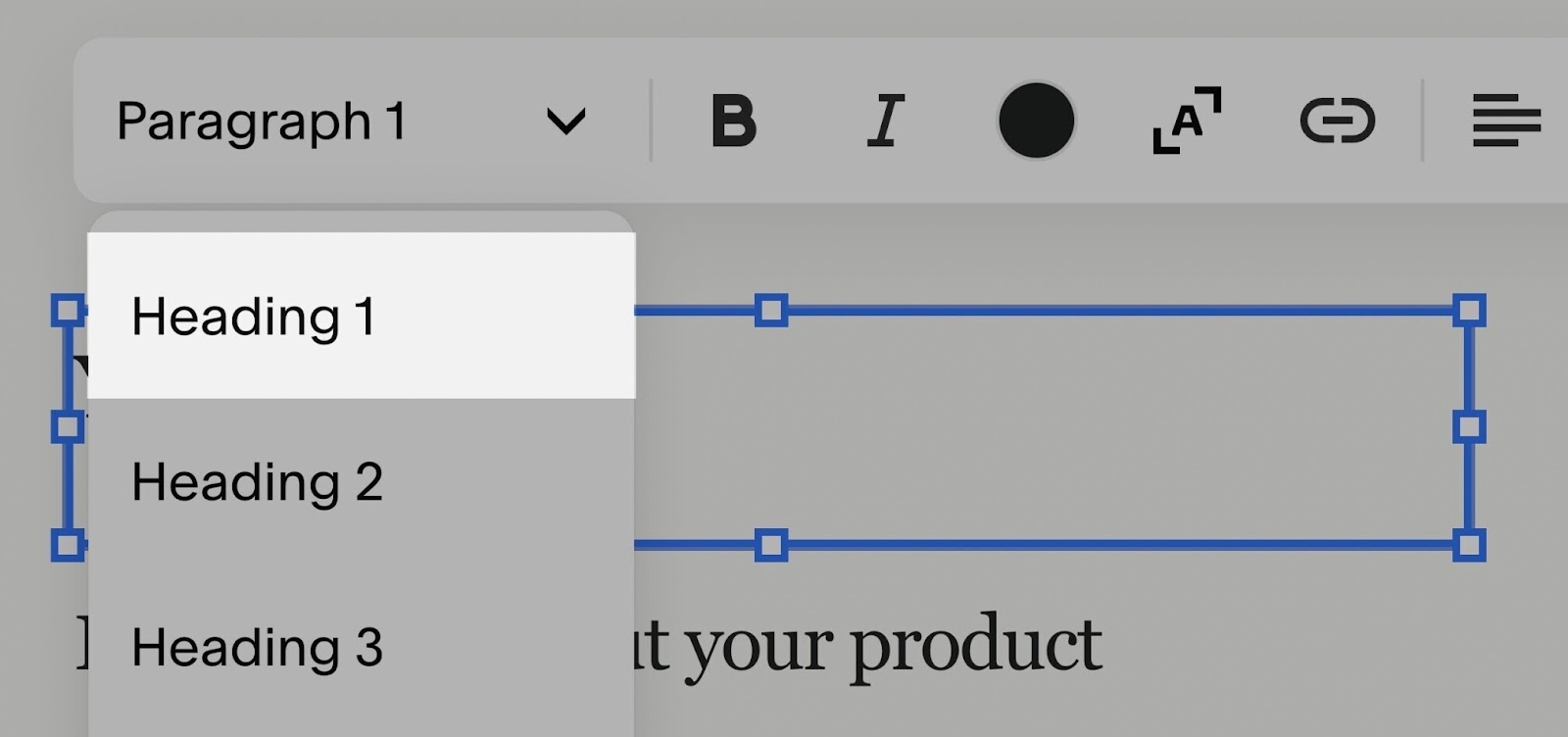
And also you’re completed!
Including an H1 Tag in Wix
Wix additionally robotically makes your weblog publish title the H1 tag.
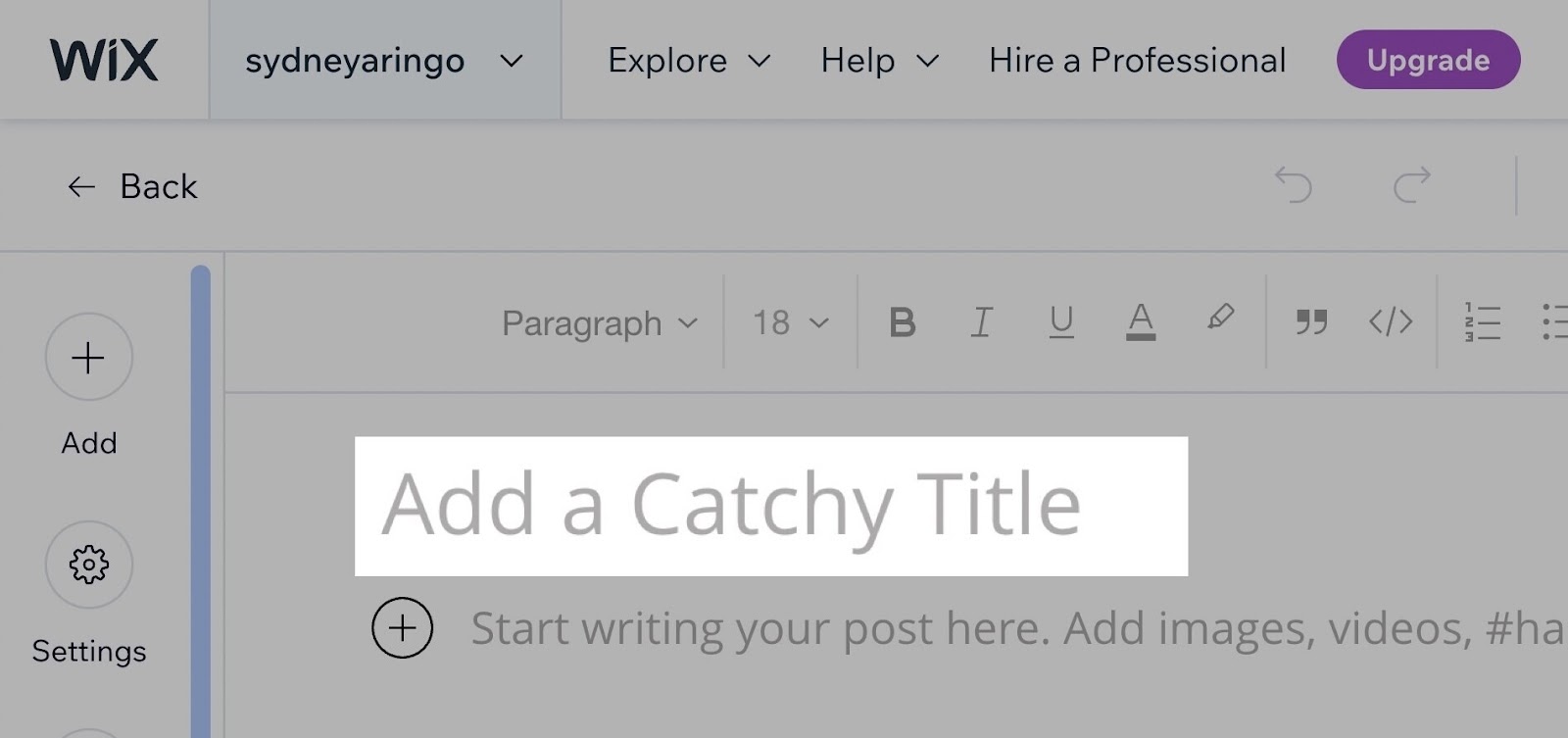
However in contrast to the opposite two CMSs on this listing, the H1 tag is simply an choice for the publish title. Which means you possibly can’t change every other subheading to be an H1.
H1 Tag Finest Practices
Listed here are six H1 tag greatest practices you possibly can observe to enhance your Search engine marketing.
1. Use a Single H1 Per Web page
Utilizing only one H1 creates hierarchy and offers your web page a extra logical construction.
It makes it straightforward for readers (and people utilizing display screen readers) to skim and perceive what your web page is about.
The H1 is for the headline conveying the principle subject. The H2s are for necessary subheadings. The H3s are for subheadings that assist these. And so forth:
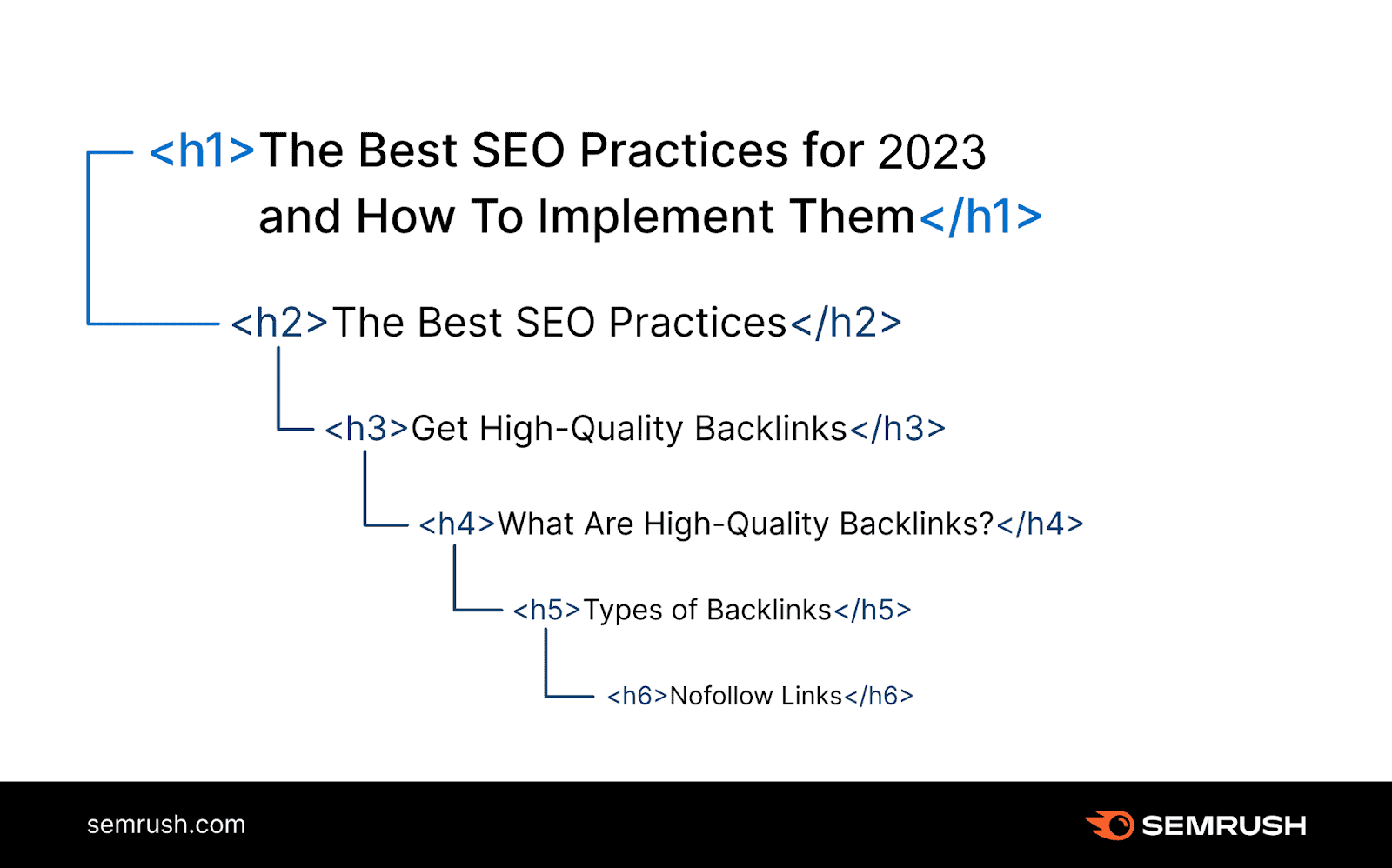
So, what number of H1 tags per web page?
Every web page ought to have just one primary subject. And that ought to be your solely H1.
2. Make Certain Each Essential Web page Has an H1
Contemplating that an H1 tag is crucial heading, each necessary web page ought to have one.
Which pages are thought-about necessary? That’s as much as you. However an excellent place to start out is with any web page you wish to rank on Google.
To search out pages with lacking or empty H1s:
- Go to Site Audit
- Enter your homepage URL and click on “Begin Audit”
- Click on on the “Points” tab
- Kind “h1” within the search bar
- Click on on the warning for pages that don’t have an H1
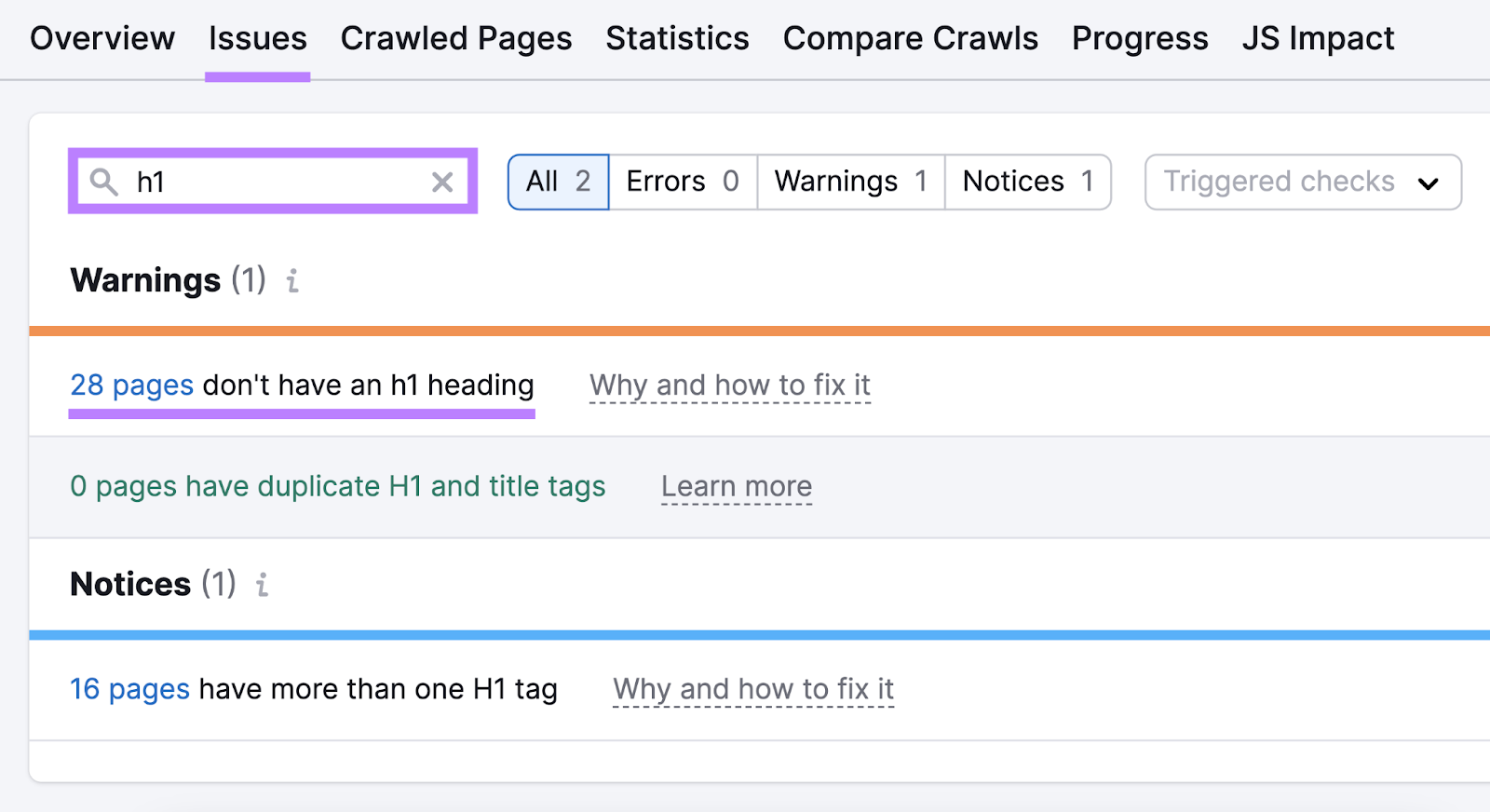
You’ll then see an inventory of affected pages. Which you’ll be able to handle by including an H1 to every.
3. Embody Your Goal Key phrase
Alongside together with your title tag, Google scans content material like your H1 to find out whether or not it’s related to a searcher’s question.
In different phrases:
A web page with an H1 that mentions the search time period is more likely to rank higher for that question than a web page with an H1 that doesn’t.
We do that for all our weblog posts.
Under, you possibly can see how we included the key phrases “title tags” and “alt textual content” in two totally different weblog publish H1s:
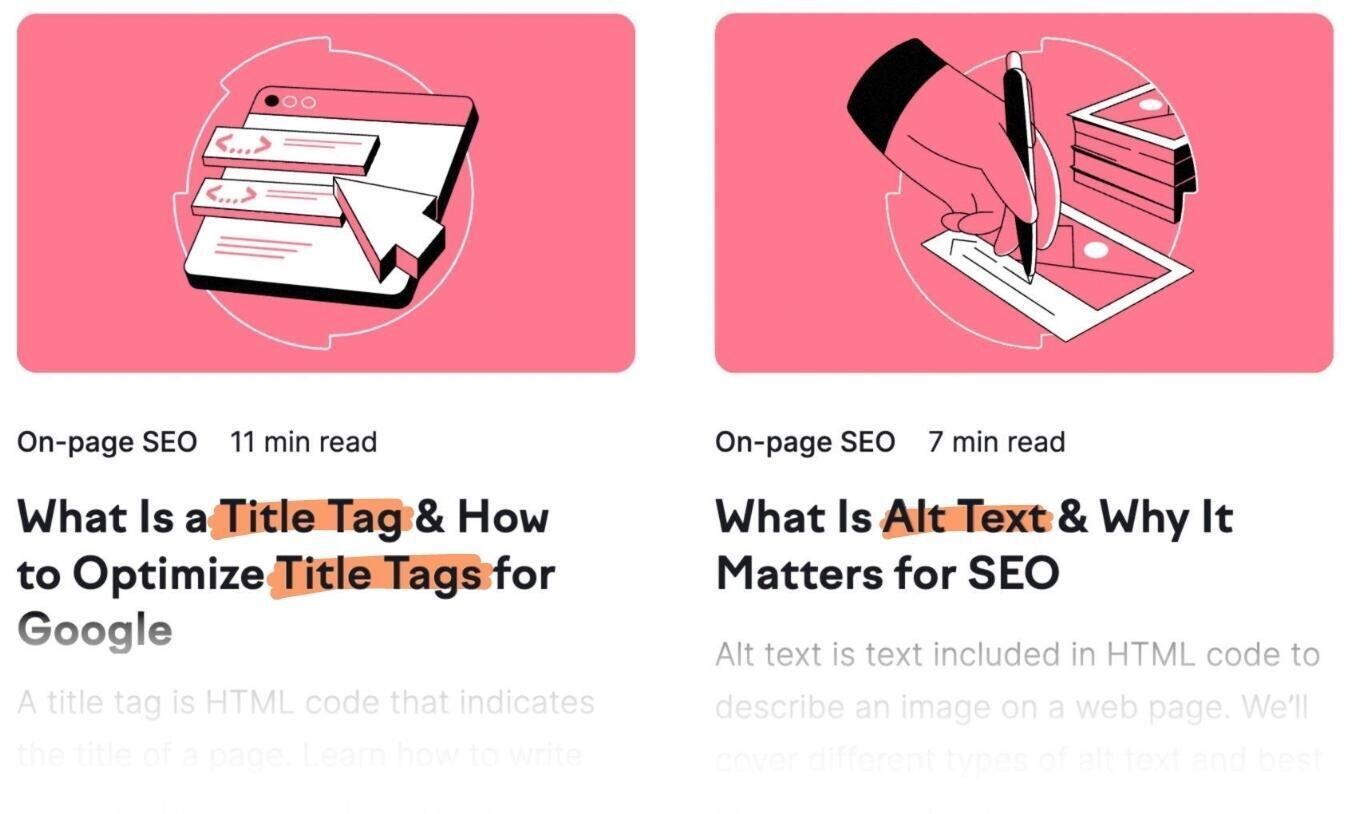
4. Hold H1 Tags Beneath 60 Characters
The clearer and extra concise you make your writing, the higher. It’s no totally different for H1 tags or different headings.
The most effective follow is to maintain it between 50 and 60 characters—identical to your title tags.
Why?
Many CMSs use the identical copy in your H1 and title tag. Plus, Google often switches title tags for H1 tags. And also you don’t need Google to truncate it within the search outcomes like this:

So, there’s no technical restrict to the size of an H1 tag. However your greatest wager is to maintain it below 60 characters.
5. Match Your H1s to Your Title Tags for Article Pages
A typical SEO mistake is to confuse the title tags added within the <head> part of your code with H1 tags. As a result of each the title tag and H1 tag describe what a web page is about.
The primary distinction is the place they seem.
Title tags seem on the prime of the browser tab. And will seem on search engine outcomes pages (SERPs). Aside from that, they’re not seen on the webpage.
Right here’s an instance of a title tag in a browser tab and in a SERP:
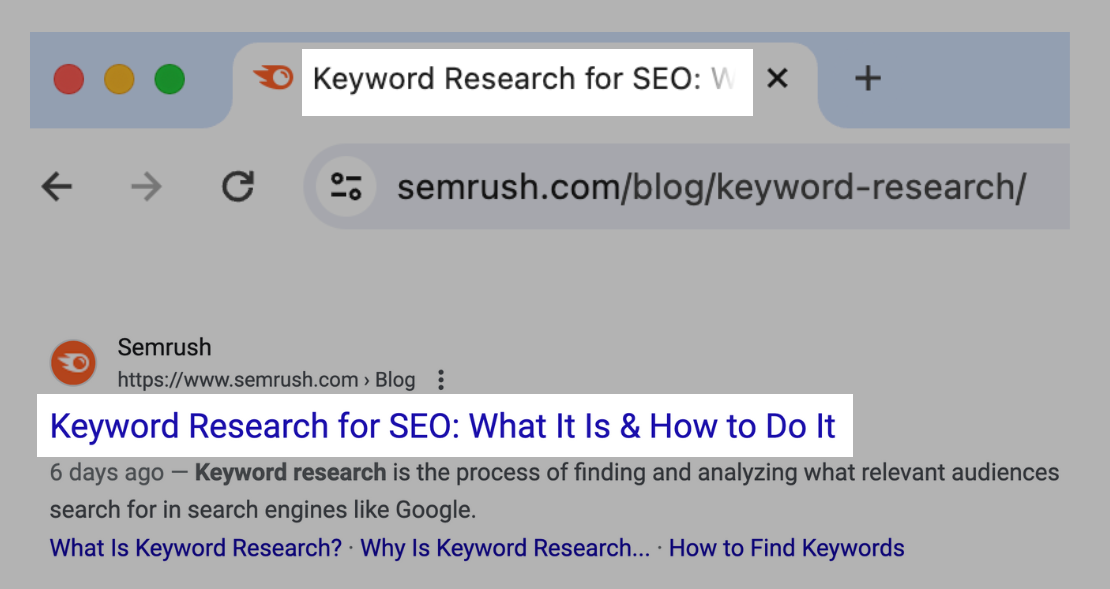
H1 tags are what customers see on the web page, typically in giant textual content. They normally don’t seem on SERPs in the event that they differ from the title tag.
Right here’s an H1 for one in all our weblog posts:
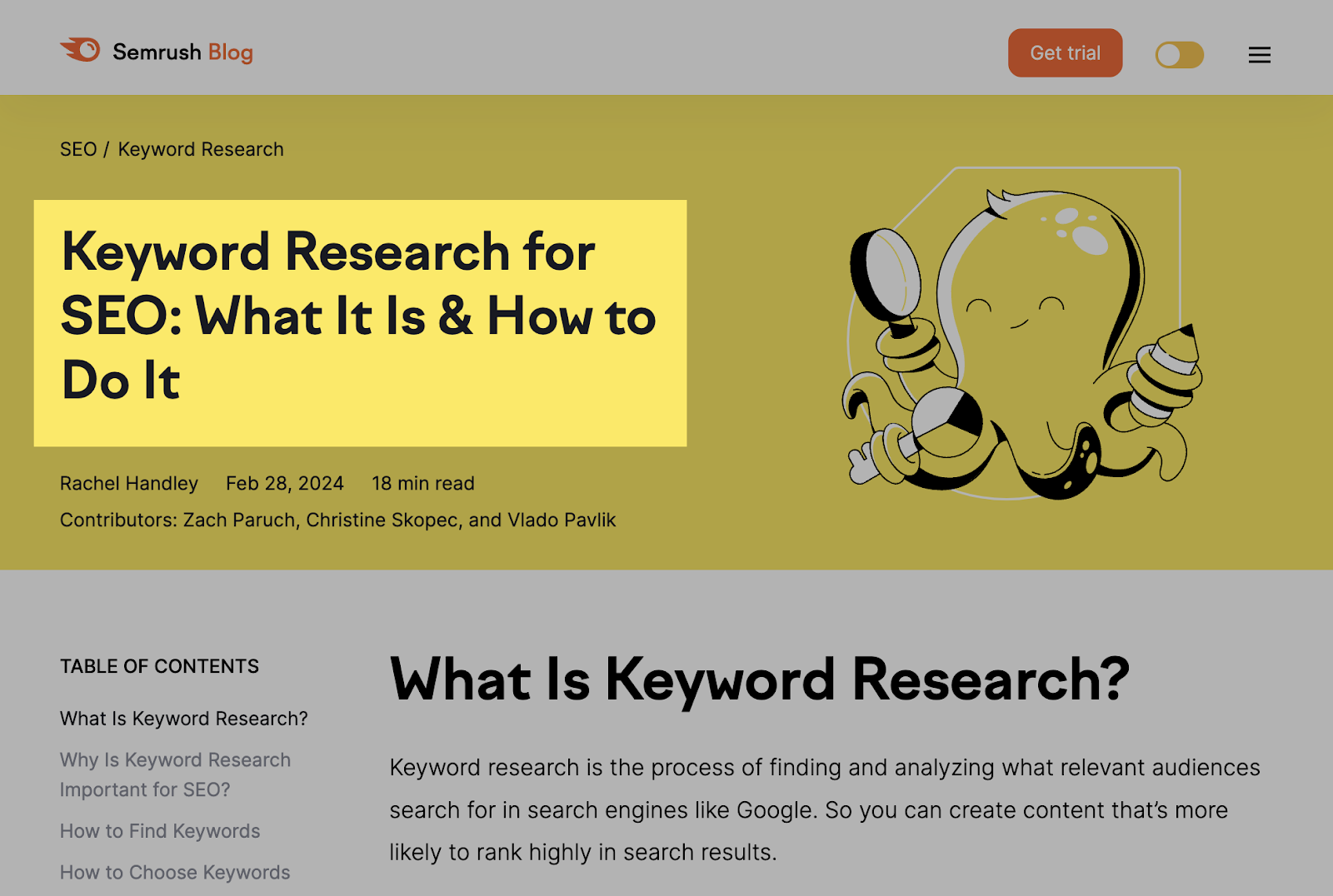
Google recommends matching your H1 tags to your title tags to forestall inaccurate article titles from exhibiting up in search outcomes.
If they’re totally different, they need to be very comparable.
Like this:

Customers will really feel deceived in the event that they land in your web page and see a very totally different (and unrelated) H1. You do not need that.
6. Optimize Your H1 to Fulfill Search Intent
Search intent is a person’s main goal when trying to find one thing.
Your H1 ought to instantly inform the reader that you just’re going to fulfill their search intent.
In different phrases:
Your content material goes to present them what they need.
Satisfying intent is necessary as a result of it’s Google’s main goal. Which, makes it a main aim for you if you’d like higher rankings.
To find out the search intent for a key phrase, kind it into Google and analyze what comes up.
For instance, the highest outcomes for “content material advertising and marketing” give attention to explaining what content material advertising and marketing is:
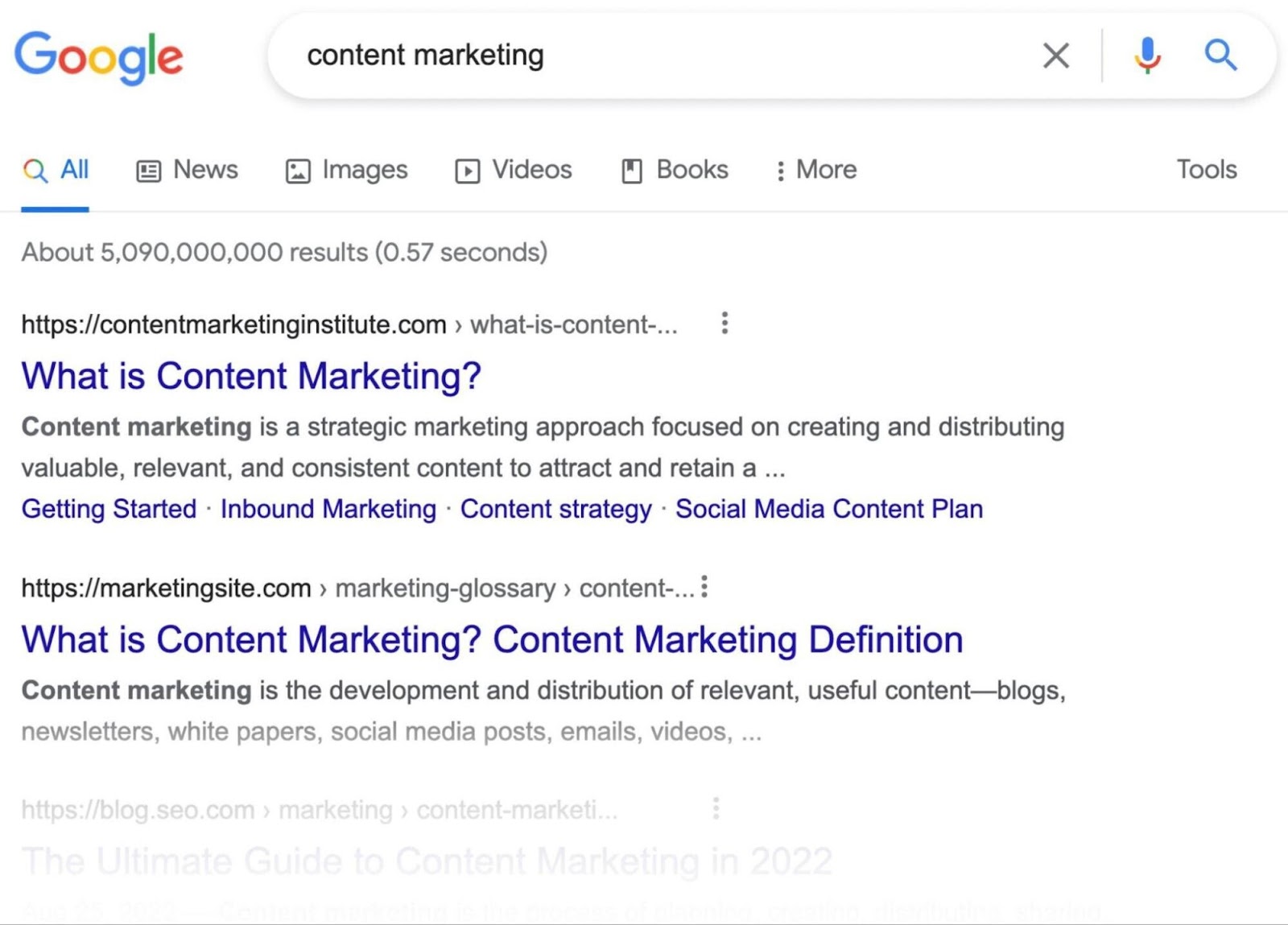
None of these articles are too in depth. Additionally they aren’t promoting something. That tells us the search intent is informational, with articles written for individuals who wish to be taught one thing.
This implies we have to write an H1 (and accompanying publish) that satisfies that informational search intent.
A good faster option to decide search intent is with Keyword Overview.
Kind in your key phrase and click on “Search.”
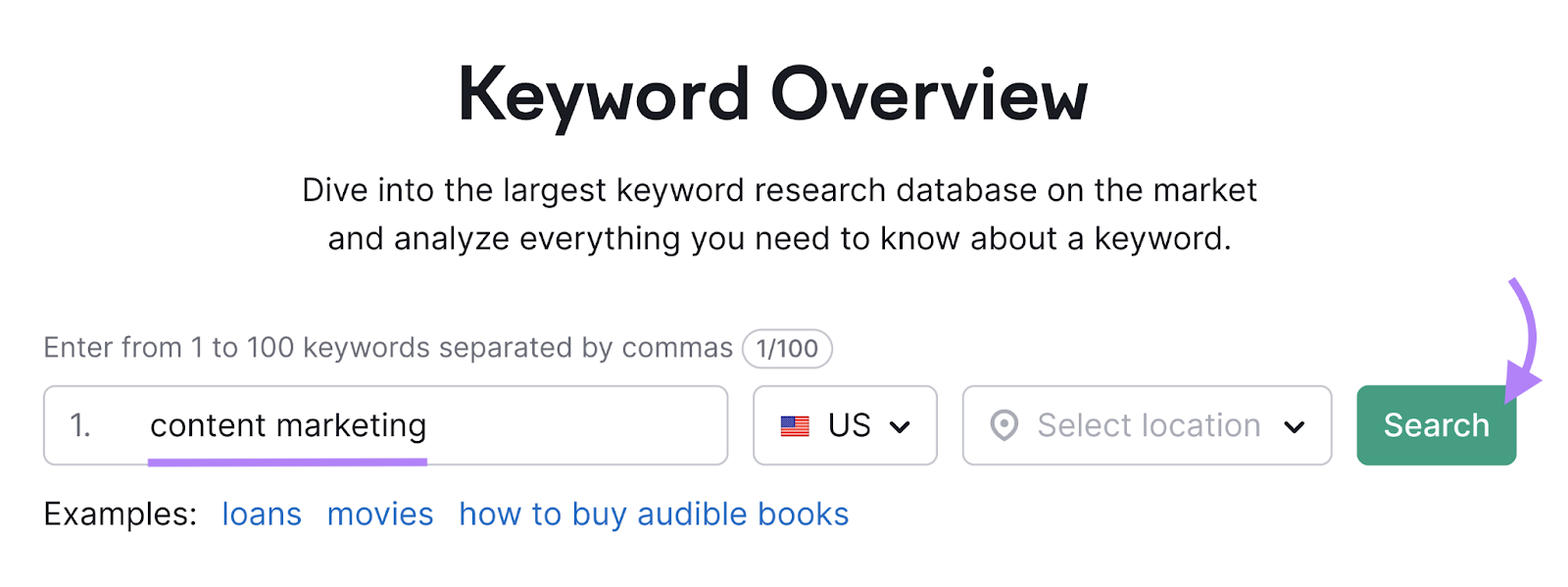
This can pull up details about your chosen key phrase, together with its intent.
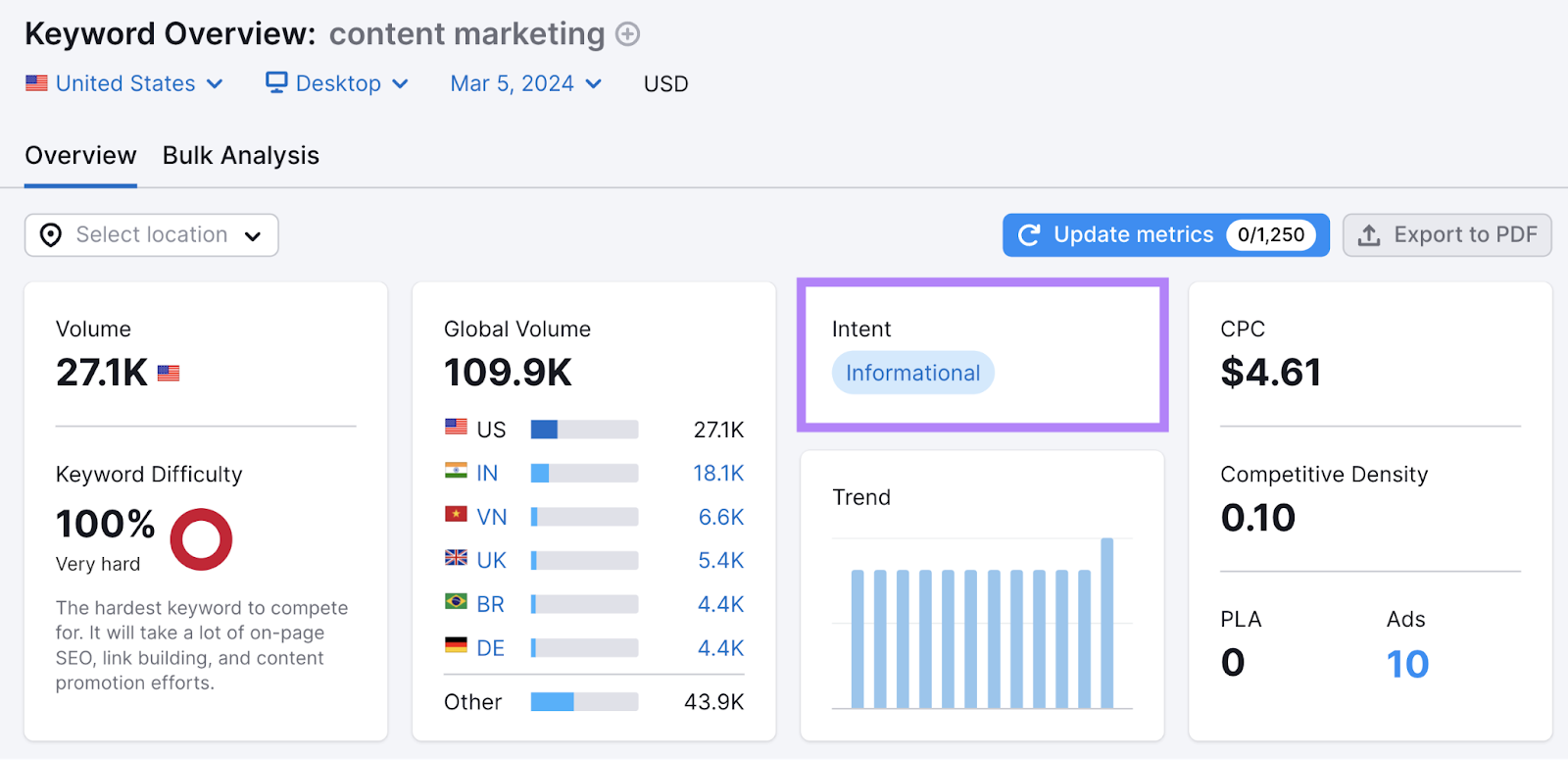
Easy methods to Run an H1 Tag Audit
To test your web site for any H1 tag errors, run an audit.
Open Site Audit. Then, paste in your area title and click on “Begin Audit.”

The device will present a dashboard together with your website’s general well being.
Click on on the “Points” tab to see the listing of issues.
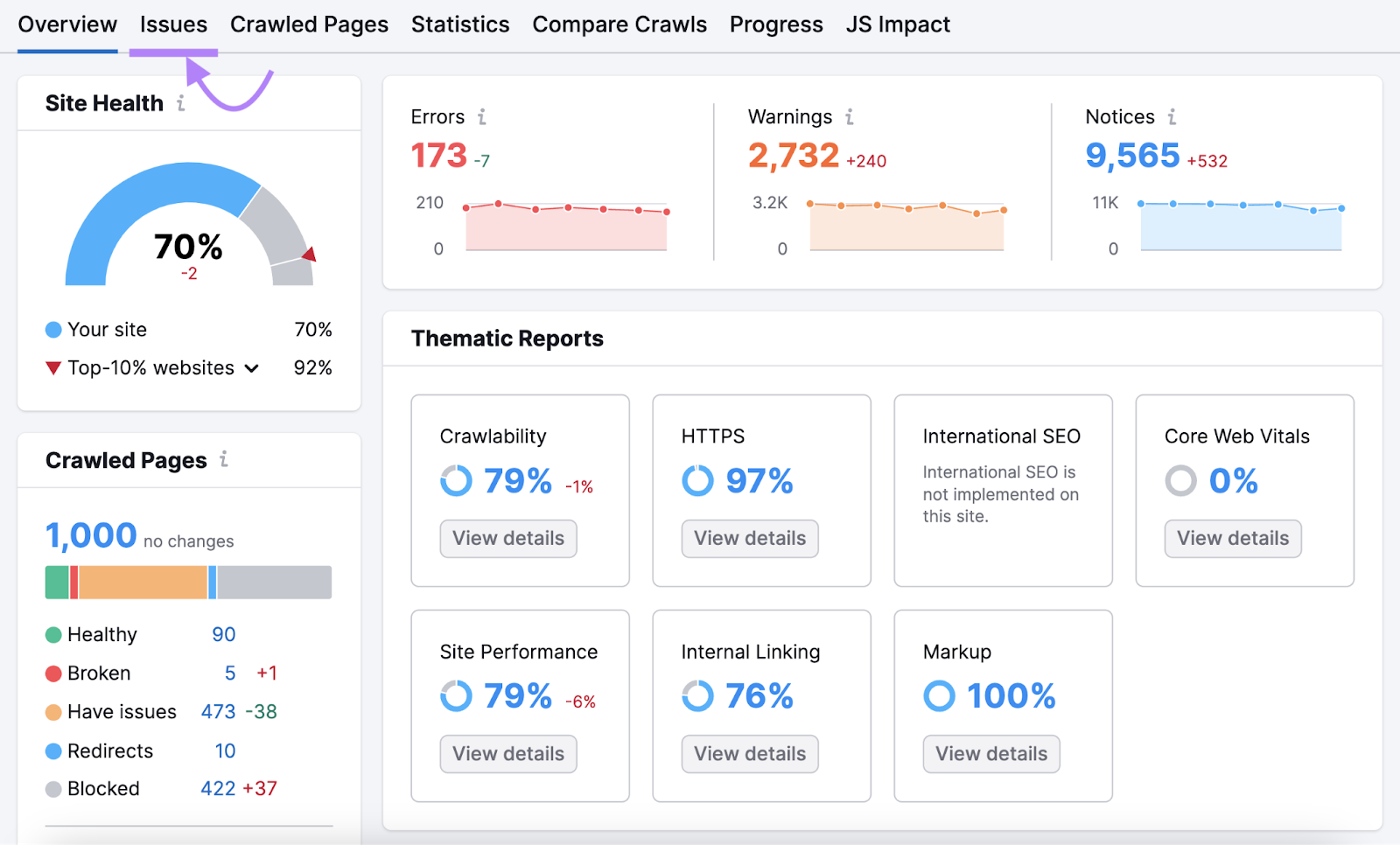
Within the search bar, kind in “h1.”
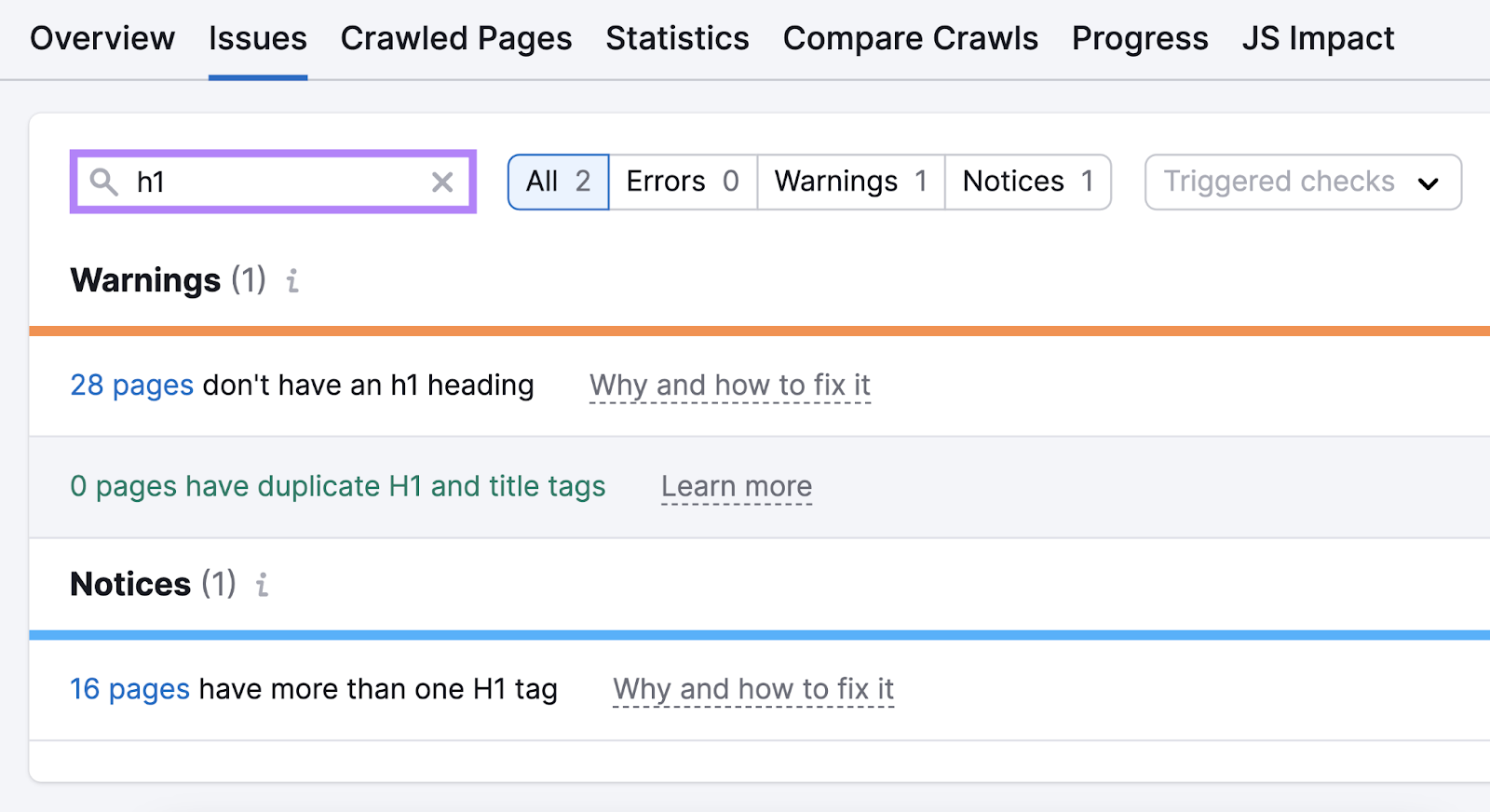
Now, you possibly can see all pages which have H1 points. Repair warnings first, then notices.
We suggest working common audits to inform you of any new points that want your consideration.
To do that, arrange a recurring report.
Within the prime right-hand nook of your Web site Audit dashboard, click on the gear icon.
Discover “Schedule” by scrolling down by the settings.
Like this:
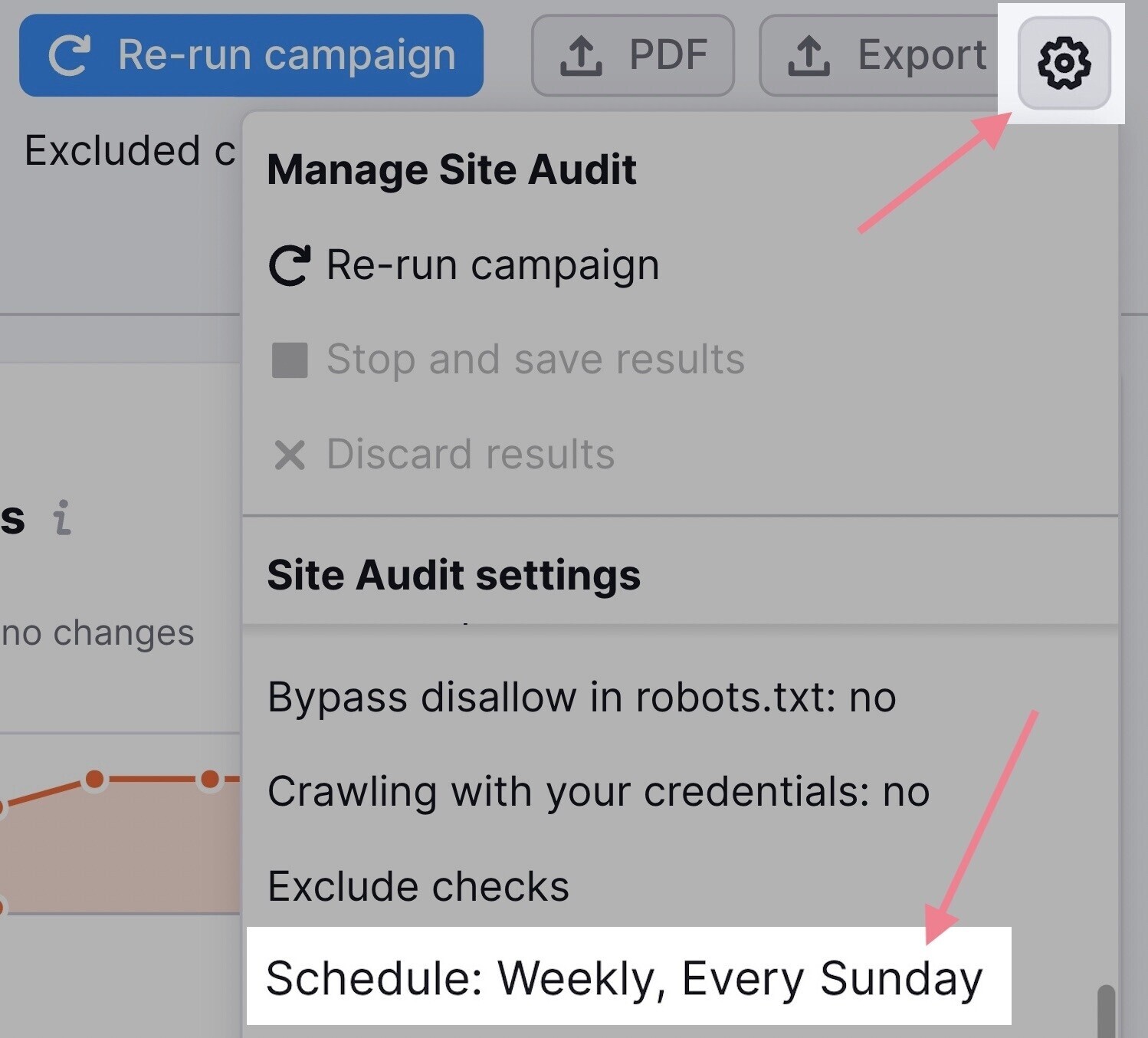
Subsequent, you’ll see a pop-up the place you possibly can select how typically to run your report.
Set it to your most popular day. And ensure to click on on the “Ship an e mail” choice on the backside of the pop-up. Then, click on “Save.”

That approach, you’ll have the ability to repair any points and hold your Search engine marketing efforts working easily.




